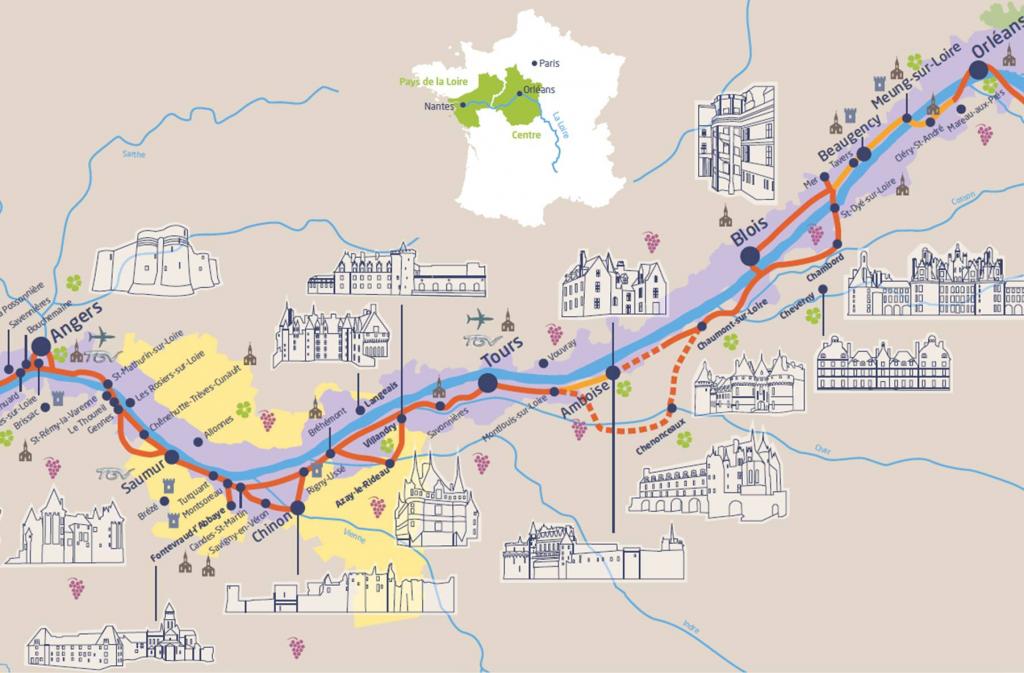Photo Journal: Loire Valley
The Loire Valley
This weekend IES sponsored a trip to the Loire Valley: a rural region in France known for historic, 16th-century castles and, of course, wine. Over the course of the trip, we visited a total of three castles, learned about the incredibly confusing early history of France, and basked in the fresh air of the French countryside.

Chateaux de Chenonceau
Our first stop of the trip was in the small town of Chenonceaux to visit the castle there that is famous for its gallery that spans the River Cher. First, though, we stopped for lunch at a lovely restaurant and had a traditional western French meal of chicken, mashed potatoes, veggies, creme brule, and coffee. After that, we walked across the railway tracks and found ourselves on the doorsteps of the castle.
We did an audio tour of the estate and were able to really uncover the amazing history of this beautiful castle. The current castle on the property passed through the hands of seven different Queens and a multitude of Kings between the years of 1513 and 1891 including Charles VIII, Francis I, Henry I, Catherine de'Medici (wife to Henry II), Louise de Lorraine (wife to Henry III), Louise Dupin, among other. It was a rich story of betrayal, heartbreak, powerful women and (per usual with the monarchy) deceptive kings.
(The walkway to the castle)
(A majestic view!)
(The in-house chapel complete with a resting place for Marguerite Pelouze, the last Queen to run the estate, only she had to sell the property before she died so it still remains empty to this day)
(One of the several royal bedchambers)
(The glass windows still have a green/blue tint from when they were once stained, you can only really see it up close)
(The gallery spanning the river where countless balls and galas were held)
(One of the first straight stairways in as castle in France courtesy of Marguerite Pelouze's ingenuity)
(Another royal bedchamber)
(The drawing room--aptly named as it has dozens of drawings of the castle on the walls)
(Like the hints of stain in the old glass, on the tiles near the walls you can still see remains of the ornate, hand-painted tiles that adorned the entrance hall floors)
(The second-floor hallway)
(The pristine outdoor gardens designed by Catherine de'Medici)
(A feat of engineering to this day)
Blois...
After our tour, we piled back into the van and drove to the small town of Blois. There, we checked into our hotel and had a great dinner of veal, more veggies, shrimp on guac and a dense chocolate cake. After dinner, my friends and I took a stroll around the town and spent some time at a local pub hanging out with the locals!
(From left to right: me, Emily, Lizbeth, and Lala. Our friend Addie is taking the photo)
...and Chateaux de Blois
This castle is comprised of several different castles, the oldest dating back to the 13th century. Because different parts of the castle were built at different times, a variety of architecture can be seen depending on what building you're in. For example, there is 13th-century Medieval architecture, The Louis XII wing represents flamboyant Gothic work, Renaissance in The Francois I wing, and Classical in the Gaston of Orleans wing. This is also the site where Joan of Arc was blessed before going into battle.
(Unfinished planning designs from the 15th century)
(A spiral staircase inspired by Leonardo Da Vinci)
(The external view)
(Feeling very royal in the 13th-century ceremonial hall)
(A little, and yet ornately decorated piano in one of the many entertainment halls)
(The chapel constructed for Catherine de'Medici featuring Lizbeth, Addie, and Emily)
(The gorgeous ceiling of the Gaston de Orleans wing)
(Lizbeth testing out the royal processional staircase)
(A mysterious woman missing a concerning number of limbs)
(Me and a very grouchy wind god)
(Addie bidding the quaint town of Blois "Adieu"!)
Chateaux Chambord
Our final stop is the renowned Chateaux Chambord, most famous for inspiring the design of the Beast's Castle in "Beauty and The Beast." This castle was begun by Francis I, although he did not complete it. Despite it being the largest and arguably the most ornate of the Loire Valley castles, it was merely a hunting lodge and show of power for the monarchy. This castle is built in traditional Rennaissance architecture in a grid formation, drawing most of it's most recognizable features from the work of Leonardo Da Vinci. This is apparent, of course, from his double-helix staircase running up the center of the keep.
(The other castles paled in comparison in terms of sheer size. With 440 rooms, 282 fireplaces and 84 staircases)
(Her majestic view of the gardens)
:-)
(It was almost too easy to get lost in)
(Each hall was massive, looming and, for most of them, remarkably empty. Much of the original furniture was auctioned off during the French Revolution. Also, peep Lizbeth being a cutie)
(The ornate top to Da Vinci's masterpiece)
(I tried to count the windows but lost count somewhere after 50 or so)
We returned home Saturday night, our brains exploding with the names of French royalty and styles of architecture. We had forged new friendships and relished in a few hours away from the hustle and bustle of city life. Our next program trip will be to Versailles on the 21st and I can't wait to see what that trip brings.










































Comments
Post a Comment